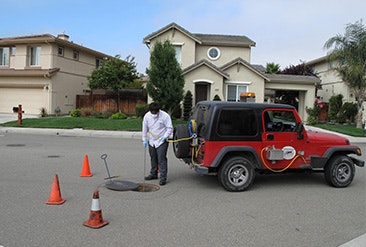Chemical Control

Chemical control refers to the use of specific compounds to either control immature mosquitoes (larvicides) or mature mosquitoes (adulticides). Only those pesticides registered by the United States Environmental Protection Agency and California Environmental Protection Agency are used by the District for mosquito control. The application of pesticides by the District is regulated by the California Department of Public Health, California Department of Pesticide Regulation, and the County Agricultural Commissioner.
Three types of larvicides are used by the District: biorationals (discussed in the Biological Control section), growth regulators, and surface films.
Methoprene is an insect growth regulator widely used by mosquito control districts. Methoprene mimics a natural juvenile hormone, and when present in the larval habitat it keeps immature insects from maturing into adults. Unable to develop into adults, the mosquitoes die in the pupal stage.
Surface agents such as refined mineral oils or monomolecular films spread across the surface of the water to prevent mosquitoes from breathing. Mosquito larvae and pupae breathe through tubes called siphons that extend above the water surface. Depending on the product, the film may remain on the water’s surface from a few hours to a few days. Surface films are the only available products that are effective against late stage larvae and pupae.
Adulticides are insecticides that reduce adult mosquito populations. The application method used to target adult mosquitoes is known as ultra-low volume (ULV) spray. A small amount of material (between 1/2 to 1 ounce per acre) is atomized into small droplets and broadcast in a fog aimed at where the adult mosquitoes are active. This method can be effective up to 300 feet away with ground applications and even further by aircraft with aerial applications, helping reduce the numbers of biting mosquitoes and the risk of mosquito-transmitted diseases.
The most common materials used for ULV spraying are classified as pyrethrins. Pyrethrin is a naturally occurring substance harvested from chrysanthemums, and it degrades within 4 to 6 hours after spraying. Pyrethroids, a synthetic form of pyrethrins, are also commonly used.

